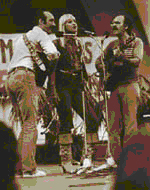FOLK REVIVAL
The folk genre was pioneered by Woody Guthrie, who sang topical songs (songs about current issues in society) and protest songs about outlaws, politics, and class relations.
In the 1960s dozens of new bands and artists rediscovered folk songs and made them into successful hit songs. Singer-songwriters like Bob Dylan and Joan Baez broke new ground in lyrical approach and personal style in composition.
The Byrds' arrangement of Dylan's "Mr. Tambourine Man" helped to start the trend of Folk rock. Dylan continued, with his "Like a Rolling Stone" becoming a US hit single. Neil Young's lyrical inventiveness and wailing electric guitar attack created a variation of folk rock.
 The folk revival brought with it the return to music as a medium for communicating a message. Songwriters such as Bob Dylan, Pete Seeger, Tom Paxton and Woody Guthrie catalogued the times in their songs. People like Odetta, Buffy St. Marie, Joan Baez, Richie Havens, and Peter, Paul and Mary helped carry the message to the primarily older, college age portion of the youth movement. The folk revival brought with it the return to music as a medium for communicating a message. Songwriters such as Bob Dylan, Pete Seeger, Tom Paxton and Woody Guthrie catalogued the times in their songs. People like Odetta, Buffy St. Marie, Joan Baez, Richie Havens, and Peter, Paul and Mary helped carry the message to the primarily older, college age portion of the youth movement.
The most prominent artists to emerge from the folk tradition include Bob Dylan – "The Times They Are A-Changing", "Blowing in the Wind"; Joan Baez - "One Tin Soldier"; Phil Ochs – "I Ain't Marching Anymore", and the trio known as Peter, Paul, and Mary – "Blowin' in the wind". Other folk rock artists include Simon & Garfunkel, The Mamas & the Papas and Joni Mitchell.
|

